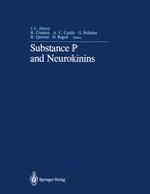1987 | OriginalPaper | Buchkapitel
Characterization of Tachykinin Receptor Subtypes Using Selective Ligands
verfasst von : R. Laufer, E. Rubini, C. Gilon, M. Chorev, Z. Selinger
Erschienen in: Substance P and Neurokinins
Verlag: Springer New York
Enthalten in: Professional Book Archive
Aktivieren Sie unsere intelligente Suche, um passende Fachinhalte oder Patente zu finden.
Wählen Sie Textabschnitte aus um mit Künstlicher Intelligenz passenden Patente zu finden. powered by
Markieren Sie Textabschnitte, um KI-gestützt weitere passende Inhalte zu finden. powered by
Early attempts at classification of tachykinin receptors were based on the finding that various tachykinins displayed distinct rank order of potencies when tested by different bioassays. Iversen and colleagues [I] identified two profiles of agonist potencies: the SP-P type in which physalaemin and substance Pare slightly more potent than eledoisin and kassinin, and a second profile, designated SP-E type, which is characterized by considerable higher potenices for eledoisin and kassinin than for substance P and physalaemin. Although this classification was found useful and stood the test of time, several lines of evidence suggested the existence of yet a third tachykinin receptor. The discovery of neurokinin A and neurokinin B, which together with substance P constitute the mammalian tachykinin family of peptides, raised the possibility that each tachykinin acts as a preferred ligand for a particular receptor Subtype. Binding studies using radiolabeled substance P, eledoisin and neurokinin A revealed unique patterns of distribution in different regions of the central nervous system and distinct profiles of tachykinin potencies in displaying each tachykinin radioligand. It should be pointed out however that the naturally occuring tachykinins are not highly selective and act on all tachykinin receptors. Also many tissues may possess a mixture of different tachykinin receptors and thus deviate from the classical SP-P and SP-E types.
